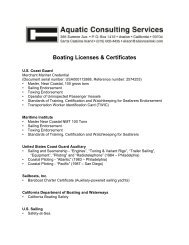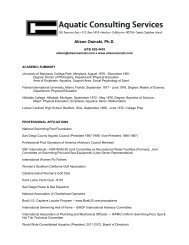NATIONAL JOURNAL - Aquatic Consulting Services
NATIONAL JOURNAL - Aquatic Consulting Services
NATIONAL JOURNAL - Aquatic Consulting Services
You also want an ePaper? Increase the reach of your titles
YUMPU automatically turns print PDFs into web optimized ePapers that Google loves.
Drowning (continued from page 7)<br />
drowning consists of the immediate application of artificial<br />
respiration accompanied by external cardiac compression.<br />
Survival of the victim depends on the fitness<br />
level of the individual, the duration of the submersion,<br />
the amount of water inhaled, and the speed of treatment.<br />
10<br />
Psychological Response To Drowning<br />
The degree of psychological distress experienced varies<br />
from victim to victim depending on the type of drowning<br />
involved, the length of submersion, and the mental<br />
awareness of the victim to the struggle. Of course, only<br />
those who have survived near-drownings, or those who<br />
drowned but were later revived have been able to<br />
describe the pain and suffering they experienced, their<br />
emotional state and what they were thinking while they<br />
were drowning. Although a drowning victim has a somewhat<br />
distorted view of reality, a common story has<br />
emerged in interviews with persons who experienced<br />
drownings and lived to tell about it.<br />
Nemiroff s (1980) retrospective interviews with persons<br />
who survived near drowning reveals that after a very<br />
brief panic filled struggle while submerged, victims were<br />
overtaken by a "pleasant, hazy, floating, blue sensation.<br />
They were calm, and in some sense found it a pleasurable<br />
sensation." In an interview with a young man who<br />
drove his car off the road into a pond, Nemiroff reports<br />
that the young man held his breath as long as he could,<br />
was forced to inhale water, felt the water burn deep in<br />
this chest, struggled briefly then became resigned to the<br />
fact that he was going to drown and die. He just let the<br />
events unfold. He felt a very hazy blue feeling and he<br />
had a sexual orgasm. The next thing he remembered<br />
was waking up injICU.<br />
Way (1983) has also reported the experiences of<br />
drowned victims. They have reported slipping below the<br />
surface after a very brief struggle and sinking to the bottom.<br />
A pleasant, hazy, floating, blue sensation like a narcotic<br />
high was felt. This frequently reported sensation<br />
may be due to a morphine like chemical substance<br />
released by the brain. Several victims described "out of<br />
body experiences" and said they were subconsciously<br />
aware of what was going on during resuscitation attempts.<br />
Tyhurst (1974) describes a drowning victim as one who<br />
experiences high levels of anxiety which result in extreme<br />
panic immediately before loss of consciousness.<br />
The victim sees no solution to the problem, his vigilance<br />
is increased, he concentrates and focuses his attention<br />
around the threat. Fear is experienced and tension levels<br />
increase. Heart rate and breathing increase, and<br />
body temperature rises. Anxiety is accompanied by a<br />
feeling of hopelessness and a demonstration of purposeless<br />
activity.<br />
In the 1962 CNCA revived victims survey, drowning<br />
victims described their feelings or actions of near drowning.<br />
Although varied and often contradictory, frequently<br />
mentioned were that it felt: like a bad dream, like<br />
I was unable to move, that there was nothing I could<br />
do, like sinking, dark, like I couldn't get air, great—like<br />
nitrogen narcosis. All those who answered the question<br />
said they passed out before being pulled from the water.<br />
It is important to remember that all near drowning<br />
victims would have been drowning victims, if someone,<br />
or something had not interrupted the drowning sequence.<br />
As Smith (1980) has said, "People don't accidentally<br />
die in the water. Rather through their own or<br />
someone else's carelessness or stupidity, they manage<br />
to kill themselves".<br />
References<br />
CNCA. (1962). [Revised water case study]. Unpublished raw data.<br />
Dietz, P.E. & Baker, S.P. (1974). Drowning: epidemiology and<br />
prevention. American Journal of Public Health, 64, 303-312.<br />
Edmonds, J.F. (1978). Drowning. In J. Palm (Ed.), <strong>Aquatic</strong> emergency<br />
care (pp. 7-8). Toronto, Ontario, Canada: Royal Life Saving Society<br />
Canada.<br />
Jokl, E. (1968). Sudden non-traumatic death associated with physical<br />
exertion with special reference to drowning. In S. Firsov & E. Jokl<br />
(Ed.), Medical Research on Swimming (pp. 235-249). New York: All<br />
American Productions.<br />
McCloy, J.M. & Dodson, J.A. (1980). Water-related fatalities in coastal<br />
Texas, 1970-78. In <strong>Aquatic</strong>s in the 80's, a report of the 21st<br />
conference of the Council For National Cooperation in <strong>Aquatic</strong>s<br />
(pp. 7-17). Atlanta, GA: CNCA.<br />
Meslin, J. (1960, February). What do you do when you're faced with<br />
the menace of drowning? Swimming Pool Age, p.15.<br />
Nemiroff, M. J. (1978, June). Cold water drowning: a new lease on life.<br />
Ann Arbor, MI: USCG and the Michigan Sea Grant Program.<br />
(Continued on page 17)<br />
CNCA'S 35TH<br />
ANNIVERSARY<br />
COUNSILMAN AND deVARONA<br />
TO BE FEATURED SPEAKERS<br />
oquotics<br />
The conference in Indianapolis this November marks<br />
the 35th anniversary of CNCA; 35 years of cooperation<br />
between more than 30 national organizations, in efforts<br />
to better aquatic education. The 1986 conference program<br />
is an exciting one, with all-time greats James<br />
"Doc" Counsilman and Donna deVarona, researchers<br />
David Costill, Marlene Adrian, and Steve Langendorfer,<br />
two Olympic coaches, and more than 40 other fine<br />
aquatics professionals speaking. Topics on legal liability<br />
and risk management, research, water parks management,<br />
aquatic administration, medical related issues,<br />
and many aspects of instruction and program will be<br />
. presented.<br />
Exhibitors will be there with product information, publishers<br />
with new books, and conference activities will<br />
provide unparalleled opportunities in idea exchange and<br />
information gathering.<br />
There will be a program exchange: a "Drop-in Center"<br />
where individual professionals will have opportunity to<br />
show their own program materials and promotional information,<br />
and exchange program ideas with others on<br />
an individual basis.<br />
There will be meetings of allied groups (American Red<br />
Cross, Boy's Clubs, Boy Scouts, etc.), tours of the natatorium<br />
and other world class sports facilities in Indianapolis<br />
— the amateur sports center of the U.S. A Certified<br />
Pool Operator's course will be offered in conjunction with<br />
the conference.<br />
Review the conference schedule, opposite, and see why<br />
YOU CAN'T AFFORD TO MISS:<br />
AQUATICS-A CHANGING PROFESSION












